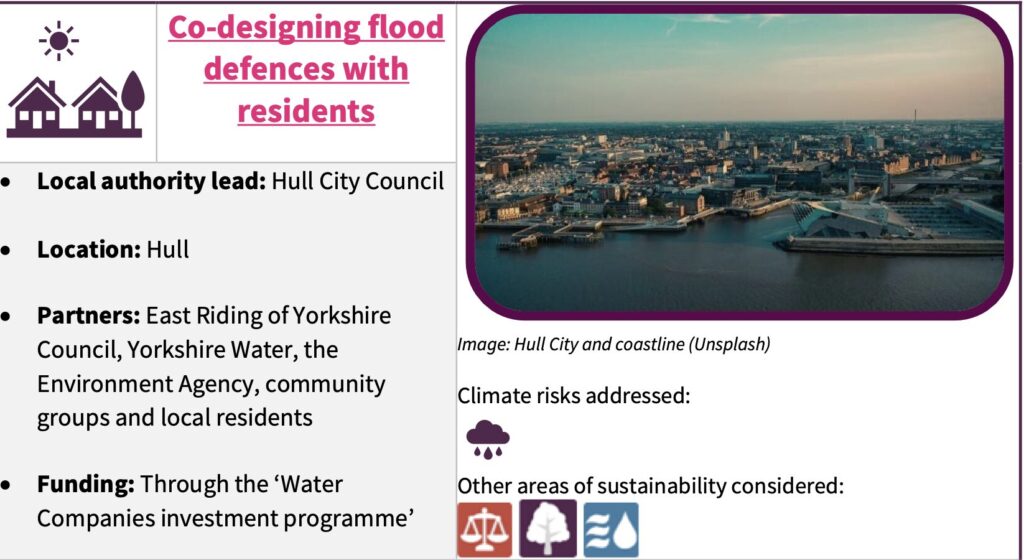New report showcases best practices in UK local climate adaptation

This article is a summary version of the original report, which can be accessed for more detail and access to details of 20 best practice adaptation projects.
Summary
Titled “Climate change adaptation: good practice examples of local planning and action,” the document was authored by Sustainability West Midlands (SWM) for Coventry City Council and CAG Consultants. It was created to inform Coventry’s own Adaptation and Resilience Plan by compiling standout plans and real-world projects from across the nation that demonstrate innovative approaches to building community resilience.
The report’s core objective is to help Coventry City Council learn from other UK local authorities and identify benchmarks against which to measure its own progress. SWM systematically gathered these examples by reviewing a range of sources, including previous research and the websites of organisations like CDP and the Local Government Association.
From strategic planning to integrated action
A key finding of the report is that successful local adaptation strategies often fall into two categories: standalone adaptation plans and integrated actions.
For standalone plans, the report gives special praise to the framework from Aberdeen City Council, calling it “our favourite”. The plan is commended for its clearly articulated drivers for action, its co-development approach with partners, and its use of quantitative measures of success for each action. Plans from other cities, such as Edinburgh and Cambridge, are also recognised for their clear action plans and strong evidence bases.
In terms of integrated approaches, the report highlights the importance of weaving adaptation measures into broader sustainability or Net Zero strategies.
Slough Borough Council’s Climate Change Strategy is presented as an exemplar where adaptation is given equal focus to mitigation, ensuring it is not an afterthought. Similarly,
Kirklees Council is noted for its highly integrated approach, embedding adaptation actions within wider themes like buildings and transport and setting a target to be “climate ready by 2038”.
Innovation in practice: Projects from across the UK
Beyond strategic plans, the report details over 20 specific adaptation projects that have been successfully implemented on the ground, tackling everything from flood management to urban cooling.
Red Hill Primary School in Worcestershire was one of the first schools in England to have a climate change impact assessment carried out during its design phase. Its building incorporates adaptation measures like rainwater harvesting, extra shading, and roof coverings less vulnerable to high winds.
Flood resilience & sustainable drainage systems (SuDS):
In Sheffield, the multi-million-pound “Grey to Green” project transformed redundant highway space into green corridors. This scheme not only reduces flood risk by mimicking natural drainage but also improves biodiversity and has stimulated economic development in the area.
In London, the “Counters Creek Flood Alleviation Scheme” demonstrated innovative retrofitting in a dense urban area. By installing a water storage system beneath the road, the project successfully reduced flow into the sewer during heavy storms by 97%.
Tackling extreme heat:
To combat increasing heat stress, Kent County Council implemented a project in Margate to install specialist SuDS ‘tree pits’ in two residential streets. The trees provide cooling through shade and evapotranspiration, while the pit design captures rainwater to reduce surface runoff.
The Greater London Authority launched the “Cool Spaces” interactive map to help Londoners find publicly accessible cool locations—such as libraries, parks, and water fountains—during heatwaves.
Climate-resilient buildings:
Exeter City Council has pioneered the development of “Passive homes” (Passivhaus) for the last 10 years, delivering over 100 certified properties. Critically, these homes were designed and stress-tested using future climate data to ensure their resilience to conditions projected for 2080.

Conclusion
In conclusion, this report serves not only as an invaluable resource for Coventry but also as a comprehensive guide for any local authority seeking to strengthen its defences against a changing climate. It underscores that effective adaptation requires a combination of strategic planning, cross-regional collaboration, and the implementation of innovative, place-based solutions.
Citation
Sustainability North West (2024) Climate change adaptation: good practice examples of local planning and action. Compendium prepared for Coventry City Council.

Comments
There is no content